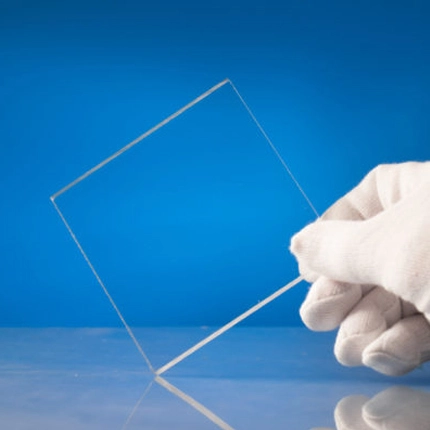
Anti-reflective glass, also known as AR glass or non-glare glass, is a type of specialty cut glass that significantly reduces the reflection from glass surfaces, enhancing transparency and visibility. This type of glass is particularly useful in applications where glare can be a problem, such as in display cabinets, digital screens, or architectural glazing where clear visibility is essential.Unlike standard glass surfaces that can reflect a significant amount of light, anti reflective glass sheet coatings reduce reflections, allowing more light to pass through and improving visibility. These specialized coatings are often applied in a decorative glass factory. Contact us for more information!
Reflection Reduction: The primary function of anti-reflective glass is to minimize reflections from external light sources, such as sunlight or artificial lighting. By reducing surface reflections, it improves visibility and reduces glare, particularly in environments with bright or harsh lighting conditions.
Light Transmission: Anti-reflective glass,a type of specialty cut glass, maintains high levels of light transmission, allowing light to pass through with minimal reflection or distortion. This ensures that images viewed through the glass remain clear and vibrant, without the distraction of reflections.
Low Surface Reflection: Anti-reflective glass typically achieves low surface reflectance values, often less than 1% per surface. This ensures that the glass appears virtually invisible, allowing for unobstructed views and optimal aesthetics.
Color Neutrality: High-quality anti-reflective glass maintains color neutrality, preserving the true colors and contrast of images viewed through the glass. It does not introduce color shifts or distortions, ensuring accurate representation of displayed content.
Durability: Anti-reflective glass is engineered to be durable and resistant to scratching, abrasion, and environmental factors. It may feature a hard coating or treatment to enhance scratch resistance and ensure long-term performance.
Easy Maintenance: Some types of anti-reflective glass may incorporate easy-to-clean properties, making it resistant to smudges, fingerprints, and dirt buildup. This simplifies maintenance and ensures that the glass remains clear and visually appealing.
UV Protection: Certain formulations of anti-reflective glass may offer UV-blocking properties to protect interior spaces and displayed items from harmful UV radiation. This helps to prevent fading and damage to sensitive materials over time.
1.1 Anti-reflective glass is coated with thin layers of materials, such as metal oxides or nano-scale coatings, that alter the surface properties of the glass.
1.2 These coatings are designed to interfere with the reflection of light, reducing both visible and ultraviolet reflections.
The primary purpose of anti-reflective coatings is to improve the transparency of glass by minimizing reflections. This is particularly beneficial in applications where clarity and unobstructed views are important.
Anti-reflective glass allows more light to pass through, making it suitable for applications where maximizing natural light or preserving the transparency of the glass is desired.
By minimizing reflections, anti-reflective glass reduces glare, making it suitable for use in display screens, windows, picture frames, and other applications where glare reduction is critical.
5.1 Display Screens: Anti-reflective glass is commonly used in electronic devices such as smartphones, tablets, computer monitors, and TVs to improve visibility and reduce reflections.
5.2 Picture Frames: It is used in framing to minimize reflections on framed artwork or photographs.
5.3 Windows and Facades: Anti-reflective glass can be used in architectural applications, such as windows, glass facades, and glass partitions, to improve visibility and minimize reflections.
Some anti-reflective coatings have oleophobic or hydrophobic properties, making them resistant to fingerprints, dirt, and water spots. This makes the glass easier to clean and maintain.
Anti-reflective glass coatings may provide some level of UV protection, reducing the transmission of harmful ultraviolet rays. This is particularly important for preserving the integrity of materials and artwork exposed to sunlight.
High-quality anti-reflective coatings are designed to be color-neutral, minimizing color shifts or distortions in the transmitted light.
Some anti-reflective glass products feature multiple layers with different refractive indices, enhancing their anti-reflective properties.
Anti-reflective glass finds applications in a wide range of industries where visual clarity, reduced reflections, and enhanced aesthetics are crucial. It is particularly valuable in environments where glare reduction and unobstructed views are essential for optimal functionality and user experience.
Pls contact us if you have any inquire or questions, thank you.
No.12111, JINGSHI ROAD, LIXIA DIST, JINAN CITY, SHANDONG PROVINCE, CHINA